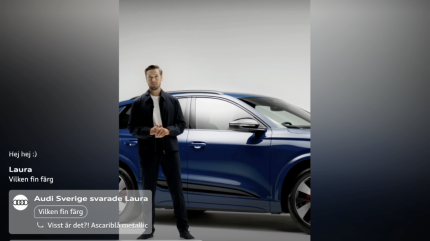
The traditional way to purchase a car – going to a showroom, speaking to the sales representative and running the rule over a showroom demo – is being challenged, especially by younger consumers. As social media and e-commerce grows, the attraction of buying a vehicle online, skipping a large portion of the in-person sales journey, has become appealing to a wide range of buyers.

Discover B2B Marketing That Performs
Combine business intelligence and editorial excellence to reach engaged professionals across 36 leading media platforms.
Some industry experts predict up to 42% of sales will be online by 2026, growing to 56% by 2030. Alongside this 83% of buyers wish they could shop for cars online, 75% say video has influenced a purchase and 29% says they would now buy their next car entirely online.
OEMs such as Audi have adapted to this new way of selling by partnering with video commerce platform specialist, Bambuser. Since the partnership Audi has launched twenty new vehicles via shoppable video, and says it has seen an increase in customer interest and engagement.
We spoke to Maryam Ghahremani, CEO, Bambuser, and Pontus Lamberg, digital marketing manager at Audi Sweden, to learn more about the benefits of such new sales platforms.

Just Auto (JA): Who are Bambuser?
Maryam Ghahremani (MG): The company started in 2007, and it was the first company in the world to do a live stream from a mobile phone. This was before the iPhone was launched. They did the first live stream with a Nokia phone with no screen. The company really pioneered mobile live streaming since the early days. A lot of journalists were using the app to stream news from the field directly into the news desk.
We decided to pivot into live shopping because of three things. The first one was e-commerce. It had been static for 25 to 30 years. To begin, it was a picture, some text and a buy button. Then everything evolved to include shipments tracking, payments, peer recommendations and so on.
We decided that e-commerce was where we want to be, ensuring that how you present your product can be more educational, inspirational, immersive, and fun.
The second reason for the pivot was video. Today, 82% of all IP traffic in the world is video; the majority of what we do all day long is spend time watching videos of all sorts – watching news, talking to our loved ones, sitting in meetings, watching YouTube, and much social media is video content, of course. Based on that, we thought that if the Internet is becoming video, then commerce will, over time, adapt and become video also. Today though, if you look at e-commerce, it’s very, very static. It’s not video first at all.
The third reason was China. They are ahead of us between five and eight years when it comes to how they behave in digital world. They’re ahead of the world. We looked at China, and we said that let’s build something that works for Western markets.
How did the company start working with automotive clients?
Today we have Mercedes, Audi, Volvo, and we are in discussions with a lot of the other big OEMs.
MG: Tesla opened the door to selling cars digitally. They opened the digital space for automotive. For us it started with Hyundai who were our first client within automotive in the US. They run a lot of live shows; they run around 10-20 shows a week. They’ve been doing it for the past four years. It’s the dealers that run the shows across the US market, and they use the live or pre-recorded solutions.
Today we have Mercedes, Audi, Volvo, and we are in discussions with a lot of the other big OEMs. I think this format is going to be a staple in the next two to three years.
How is Audi utilising Bambuser to reach their target audience?
When Audi did the live stream launch for the Q6, you could see that they had more test drives booked, viewers stayed longer, the engagement was boosted.
The live event can still be streamed on the website, they’re still picking up interest, and seeing a lot of engagements. With e-commerce you create assets and you can keep them up on your website for a while and they continue to generate interest afterwards.
They really wanted to have a channel that could help them to reach a younger audience. A lot of automotive companies want to know how they can get to a more digitalized customer journey. I think those were the two biggest things; they wanted to have a new, fresh take on the digital customer experience/journey, but also, work out how to reach the younger audience. Audi is launching over twenty new models, and they wanted to showcase all those models via livestreams, and we can help with that.
Retail today really needs to rethink the customer experience. The customer experience needs to be tailored, and personalised. It needs to be a ‘wow’ experience, and I think you can tailor it with adding more digital touch points, make it a ‘wow’ journey. Looking at automotive, it’s so old school which I think means they lose out on a lot of sales, because the younger generation are very different in their expectations.
Pontus Lamberg (PL): Audi Sweden is expanding digital platforms like Audi Live. Retail partners in Sweden are being trained to integrate these tools, ensuring a smooth transition from digital to physical. Dealers are also encouraged to localise content on their websites.
Audi Sweden saw a rise in Swedish EV sales in Q1 2025, aligning with global trends. With new EV and plug-in hybrid models coming, Audi aims to meet growing demand and strengthen its market position in Sweden.
What are the main benefits of video commerce platforms for automotive?
MG: If you look at automotive compared to the other industries, the only thing that’s more expensive is buying real estate or a property. I would class automotive as luxury because it’s very expensive. It’s not a quick add to cart and checkout. It is a complex product, it’s very technical, a lot of the standards need to be high on the sell end; you can’t just put anyone in front of a camera. You need to have education about what you’re selling and the workflows with cameras.
When we look at why are automotive using this channel to sell, I think they’re looking at the younger generation. Looking at Gen Z, it’s the richest generation ever, and in 2028 a lot of that wealth will be inherited, but they’re also making a lot of money. We predict that Gen Z is going to be the richest generation after silver spenders.
. Looking at Gen Z, it’s the richest generation ever, and in 2028 a lot of that wealth will be inherited, but they’re also making a lot of money.
Their behaviour is very different to a silver spender or a millennial. They spend an average of three times more time daily watching video, compared to a traditional web format, like a website. If you have social commerce or live streaming for your brand, you can get them to stay on your website three times longer than coming in and going out. That three times longer buys you a lot of time to educate, inspire, and create a relationship.
I think what makes this channel really strong is thinking: how can I get them into my customer relationship management (CRM) to be able to create that relationship. What we can see with that generation is that they are very social media friendly. They love social media formats, which is short form videos, very snappy, very short form.
Their attention span is short. If you want to reach them, having a flat website with picture and text won’t do it. You really need to go a bit further, I’d say, above and beyond, to create something that will catch their attention and keep it. A lot of aspiration and inspiration today happens on social media.
If they land on your website from a YouTube clip or a TikTok reel, how do you pick them up in the same mode, which is a short-form video, where they can watch, endlessly scroll, ask questions, book a test drive? It’s not just video, it needs to be interactive, engaging. Either it needs to be highly educational or very inspiring and fun. We see around 23% higher engagement when they land on a video rather than just landing on a page that’s static.
With the younger generation, what we’re seeing is that they’re quite comfortable with this; they don’t want to drive for 45 minutes to come out and look at a car. It works better for them to do the first part digital, but the last part, (which is driving the car), in person.
PL: The benefits of shoppable video are significant for both Swedish customers and Audi Sweden. For customers, it offers the convenience of accessing detailed product information anytime, along with clearer explanations of complex features, which helps build confidence in their purchasing decisions. For Audi Sweden, it results in better-informed leads, ensures consistent brand messaging across channels, and enables the brand to reach a broader audience that prefers digital-first experiences.
Shoppable videos blend inspiration, information, and interaction, letting users explore features and take action in one seamless experience — boosting engagement and speeding up decision-making
Do you see solutions such as this continuing to grow in popularity in the future?
MG: If you look three to five years ahead, I think this is going to be a commodity. I think that it’s the purchase funnel, and the customer experience together, they go hand in hand.
The automotive industry, for example, is much more aware of environmental sustainability – all those things that are elements that are hard to explain in text – but you can do that in a video for 30 seconds. You can explain why you’re a sustainable company, and how you’re a sustainable brand within this industry. Saying it with picture and text is going to be super tough.
Customers are looking for that authenticity – they want storytelling about someone that’s in love with your brand.
I think tailoring it, and having this nice journey and having the blend of both is going to be critical. I think around 2027, 2028 is going to be a turning point, because that’s when we see Gen Z being the ones with the power. I think that’s where the brands are going to hurt financially if they don’t convert into that experience.
PL: Online sales are growing but won’t replace dealerships. Instead, they complement them. Audi Sweden is building a seamless experience across digital and physical channels, giving customers flexibility while preserving the value of in-person interactions.







